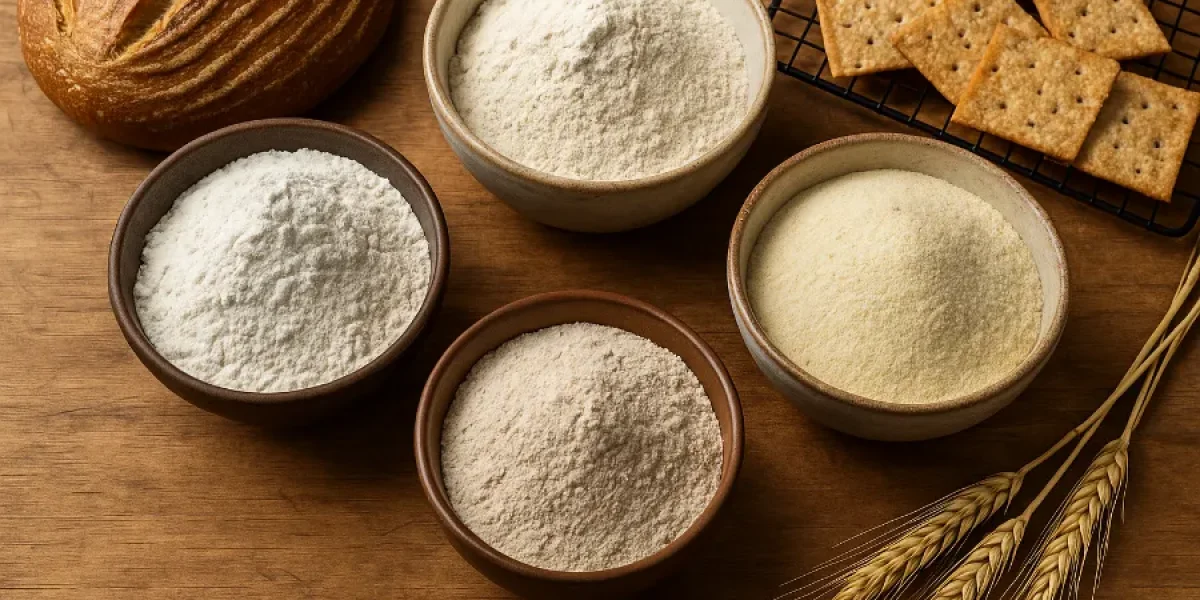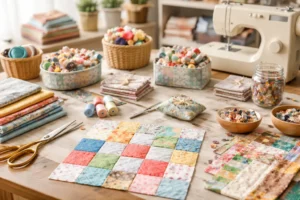When people ask me what makes great sourdough why one loaf sings while another falls flat I always start with the flour. Not the starter, not the oven spring, not even the hydration trick. It’s the best flour blend for sourdough that quietly decides whether your crust shatters or sags, whether your crumb tastes nutty or bland.
After years of mixing, feeding, and failing (sometimes spectacularly), I’ve learned that flour blending is less a formula and more a relationship. Each grain brings its own personality: strength, sweetness, color, or crunch. Once you understand how they interact, you can build blends for breads, whole wheat crackers, and even healthy baked snacks that taste like they came from an artisan bakery.
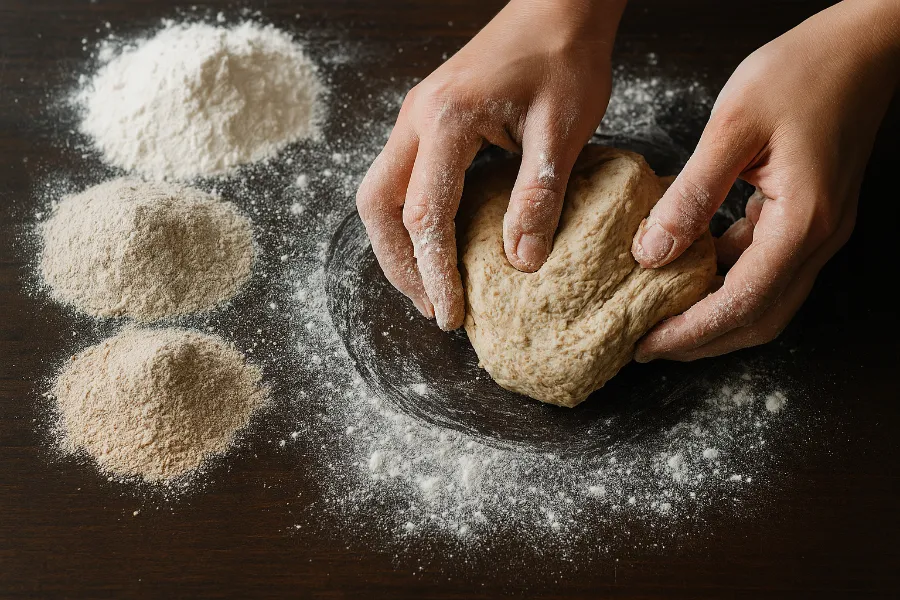
Whole Wheat Crackers
The humble whole wheat cracker taught me more about flour than any loaf ever could. Whole wheat flour is alive with bran, germ, and minerals. It soaks up water greedily and makes doughs feel rustic and hearty—but also tougher to handle if you go all in.
The trick is balance. Pure whole wheat crackers can bake dense and leathery. Blend them:
- 50 % bread flour for elasticity
- 40 % whole wheat flour for flavor and fiber
- 10 % rice or semolina flour for crisp edges
Knead gently, rest often, and roll thin—paper-thin. The bran softens as it hydrates, and the flavor deepens in the oven. The result? Toasty, nutty crackers that snap cleanly but melt like butter.
Pro tip: brush the surface with olive oil, sprinkle coarse salt and cracked pepper, and you’ll forget they’re “healthy.”
Whole Wheat Sourdough Crackers
If you keep a starter, you’ve probably faced that eternal question: what do I do with all this discard? For me, the answer became whole wheat sourdough crackers—crispy, tangy, and deeply satisfying.
The natural acidity of the discard balances whole wheat’s earthiness and boosts browning. I usually mix:
- 50 % whole wheat
- 40 % all-purpose
- 10 % rice flour for dryness
Add a spoon of honey for caramel notes or grated hard cheese for savoriness. Dock the dough like shortbread and bake hot (400 °F/200 °C) for 12–15 minutes. As they cool, they firm up into the kind of cracker that makes soup jealous.
Beyond flavor, sourdough fermentation makes these snacks easier to digest enzymes in the starter break down part of the gluten before it even hits the oven.
Healthy Crackers
The phrase “healthy crackers” used to sound like punishment. Then I learned how much fun you can have with alternative flours. The best flour blend for sourdough doesn’t have to be a purist’s mix; it can be a playground.
- Spelt brings sweetness and soft texture.
- Chickpea flour adds protein and a golden hue.
- Rye lends earthiness and keeps crackers crisp longer.
- Buckwheat gives speckles and a faint toast flavor.
A blend of 40 % all-purpose, 30 % whole wheat, 20 % spelt, and 10 % rice flour yields a dough that’s both pliable and wholesome. Bake them thin, store airtight, and they’ll stay snappy for weeks.
They pair beautifully with hummus, cheese boards, or that guilty late-night dip straight from the jar.
Sourdough Fermentation
Let’s pause for a moment on what ties all these flours together: sourdough fermentation.
When you mix flour and water with a living starter, you’re starting a slow-motion conversation between yeast and bacteria. The flour feeds them; in return, they flavor your dough.
Different flours change that conversation:
- Whole wheat speeds it up because it’s rich in minerals and enzymes.
- Rye is like caffeine—fermentation goes wild.
- White bread flour keeps things controlled and predictable.
That’s why a balanced blend works so well: you get reliable structure from white flour and rich, tangy flavor from whole grains. I usually feed my starter with a 50/50 mix of bread and whole wheat flour—it keeps the yeast happy and the flavor balanced.
During fermentation, don’t rush. Give your dough time to breathe and bubble. When it smells faintly fruity and feels airy under your fingers, that’s your cue to bake or roll.
Spelt Sourdough Crackers
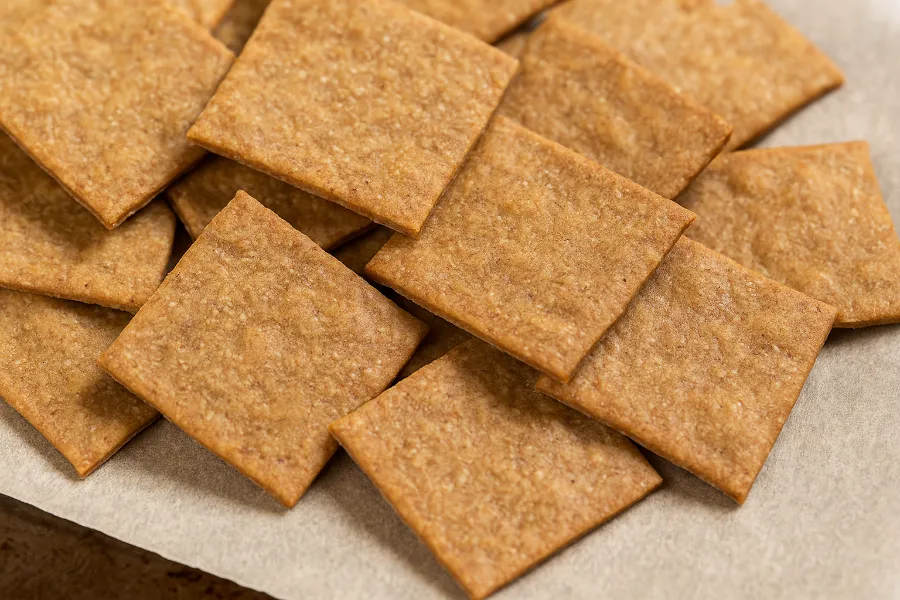
Spelt deserves its own spotlight. This ancient grain behaves like wheat’s graceful cousin it has gluten, but softer and more delicate. In spelt sourdough crackers, that means tender bite and gentle flavor.
Why I love spelt:
- It browns beautifully.
- It ferments faster, which adds depth in shorter time.
- It pairs well with seeds and herbs.
For a dependable blend, use 30 % spelt flour with 70 % bread flour. The stronger flour keeps shape; the spelt brings personality. Bake them slightly darker than you think—they’ll develop caramel undertones and a whisper of sweetness.
If you ever thought crackers were boring, try these with rosemary and sea salt. They’re the definition of simple luxury.
Healthy Baked Snacks
Once you start blending flours, you’ll realize it opens doors far beyond loaves and crackers. I use my sourdough starter for all sorts of healthy baked snacks—flatbreads, crisps, even savory granola clusters.
Three blends I swear by:
- Multigrain Crunch: 40 % whole wheat / 30 % spelt / 20 % rye / 10 % rice flour
- Light and Crispy: 70 % all-purpose / 20 % semolina / 10 % chickpea flour
- Protein Power: 60 % all-purpose / 20 % chickpea / 10 % whole wheat / 10 % rice
Each gives a different texture—some brittle, some flaky—but all deliver that clean, toasty satisfaction only sourdough can provide. I keep jars of these snacks on my counter; they disappear faster than bread ever does.
Best Flours for Sourdough Crackers Crisp Texture
Now for the real magic: how to get that crisp texture that makes sourdough crackers addictive. Through a lot of trial (and more than a few trays of chewy regret), I discovered that crispness is about the right blend of strength and dryness.
Bread flour supplies gluten strength, letting you roll thin without tearing.
Whole wheat adds flavor and color.
Rice flour or semolina steals moisture and creates that signature brittle snap.
Here’s my go-to formula for ultra-crisp sourdough crackers:
- 60 % bread flour
- 25 % whole wheat
- 10 % rice flour
- 5 % semolina
Hydration should stay low—about 55 %. Mix until just combined, rest for 20 minutes, then roll and cut. After baking, turn the oven off, crack the door, and let the crackers dry inside for ten more minutes. That’s the secret finish that transforms them from good to glassy.
The Types of Flours I Keep for Sourdough Baking
Every baker has a flour shelf that looks like a science experiment. Mine includes jars labeled in permanent marker and a fine layer of dust on everything. Here’s what each type brings:
- Bread Flour: High-protein backbone. Builds structure and chewy crumb.
- All-Purpose: Friendly, balanced, and forgiving. Great for soft crackers or sandwich loaves.
- Whole Wheat: Nutty flavor, dense nutrition, faster fermentation.
- Spelt: Slightly sweet, tender gluten. Perfect for delicate texture.
- Rye: Dark flavor and super-active fermentation. Use sparingly.
- Rice Flour: Moisture reducer; key to crispness.
- Semolina (Durum): Adds color, a hint of grit, and golden hue.
- Chickpea or Buckwheat: Flavor boosters for adventurous blends.
You don’t need them all at once. Start simple—maybe bread, whole wheat, and rice—and build your collection as curiosity grows.
The Ways to Use Each Flour for Best Results
Bread or All-Purpose Flour:
Keep them as your foundation. Use 60–70 % of your total blend. They form the gluten net that traps air and holds shape.
Whole Wheat Flour:
Limit it to 20–40 % unless you want heavy texture. Add a little extra water (1–2 %) and extend the autolyse to soften bran.
Spelt Flour:
Swap in for part of your wheat when you want tenderness. It loves shorter fermentation.
Rye Flour:
Great for starters or dark loaves, but use under 20 % in crackers—too much makes dough sticky.
Rice or Semolina Flour:
Use 5–10 % to dry doughs and enhance crispness. Ideal for thin crackers and breadsticks.
Chickpea or Buckwheat Flour:
Add 10 % for complexity and nutrition. They darken fast, so bake attentively.
These aren’t strict rules—they’re invitations to experiment. Every mill, every climate, every starter behaves differently. That’s half the fun.
Troubleshooting Crispness
If your crackers turn soft or chewy instead of crisp, don’t give up—fix the variables.
- Hydration too high: reduce water slightly.
- Rolled too thick: aim for 1 mm (you should almost see through).
- Under-baked: leave them longer; golden isn’t enough, you want amber.
- Stored warm: cool completely before sealing, or moisture will creep back in.
You can revive slightly soft crackers by returning them to a 250 °F (120 °C) oven for five minutes. They’ll crisp right back up.
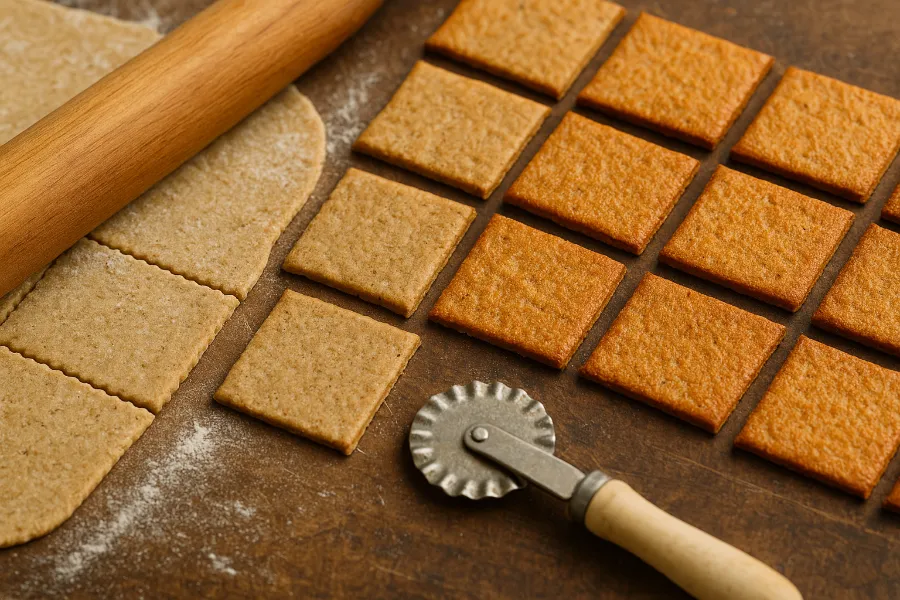
Why Flour Blending Matters
The longer I bake, the more I realize that blending flours isn’t about following ratios—it’s about listening. Each batch of flour behaves differently depending on weather, humidity, even storage age. One day your whole wheat might drink water like sand; another, your spelt might make the dough slack. Learning to feel dough under your hands—when it tightens, when it relaxes—is what separates good bakers from great ones.
That’s why the best flour blend for sourdough isn’t fixed; it evolves with you.
Final Thoughts
Sourdough is humbling because it never stops teaching you. Every new flour, every change in season, every tweak to hydration shows you something about patience and process.
For me, finding the best flour blend for sourdough has been a delicious journey—one that taught me that “perfect” isn’t a fixed destination. It’s that moment when your dough feels right under your palms, when the scent of baked grain fills the kitchen, and when the first bite cracks just so. So next time you feed your starter, open a few flour jars and start blending. Mix strength with flavor, tradition with curiosity. That’s how you’ll find your best flour blend—and maybe, your best bake yet.
FAQs
A great starting blend is 70% bread flour, 20% whole wheat, and 10% spelt or rye. It balances strength, flavor, and fermentation beautifully.
Yes, but expect denser texture and faster fermentation. Blending with bread or all-purpose flour gives better rise and structure.
Spelt makes the dough softer and more extensible. It adds a mild sweetness and helps create a tender crumb in crackers and bread.
Bread flour provides structure while rice or semolina flour creates a brittle, crisp finish. Keep hydration low for extra crunch.
Rye speeds fermentation and adds a rich, earthy flavor. Use it in small amounts—10–20%—to avoid sticky dough.
You can replace up to 20% with rice, chickpea, or buckwheat flour. These enhance flavor and crispness without weakening structure.
Fermentation breaks down phytic acid, boosts mineral absorption, and pre-digests gluten. The result is a more nutritious, easier-to-digest bake.

